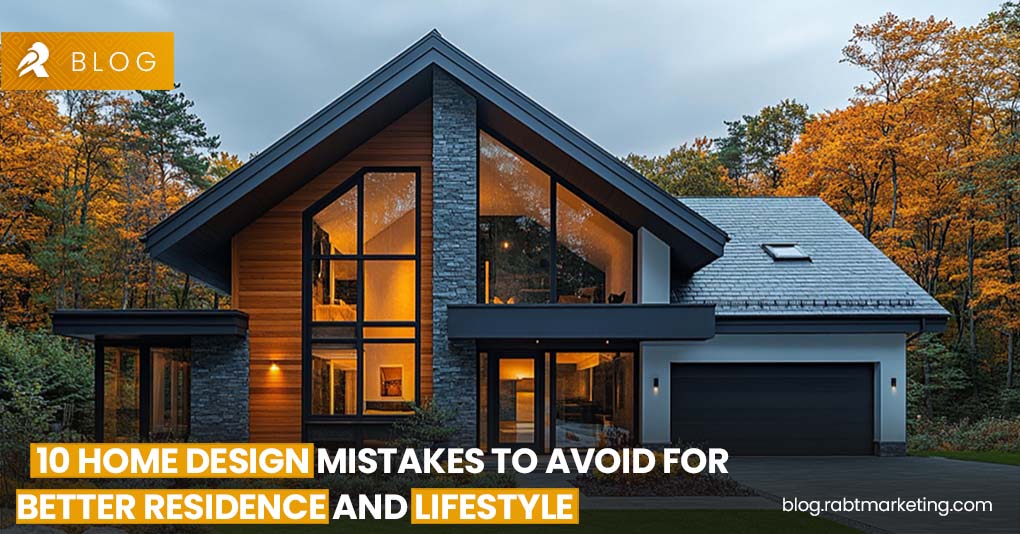If you are going to construct your own home, you’re going to invest your life-time savings and it is still a dream for many. it’s a one time opportunity of your life mostly and hence it be considered very important and critical. Small and little mistakes can lead to long-term financial loss and discomfort in life. And if you avoid these little mistakes, you can make your residential space as comfortable and beautiful as you want. In this blogpost, we try to educate you regarding a few architectural mistakes.
Top Design Mistakes to Avoid for a Better Home
1. Poor Bathroom Placement
One of the most common design mistakes is poor bathroom placement. Apparently it might seem convenient to have a bathroom close to the entryway, kitchen, or dining area. But practically this can lead to discomfort and awkwardness for both guests and residents. Instead, consider placing bathrooms in more private areas of the house, such as near bedrooms, in a hallway, or connected to a mudroom. This not only offers more privacy but also maintains the beauty of your house.
2. Designing a Wide or Deep House
A home that is too wide or too deep can feel very dark and somehow horror. Natural light is essential in making a space feel warm and open. Excessively large dimensions can limit light penetration. The ideal house width should range between 20 to 25 feet, as this allows for ample daylight to flood the interiors. More light penetration leads to a more welcoming atmosphere at your residential space. It will create a sense of life in your home.
3. Ignoring Outside Views
One of the greatest advantages of custom home design is the ability to take full advantage of your property’s views. It’s the responsibility of the architect to use the potential of surrounding views of your home in its design. It can be a scenic mountain range, a serene lake, or a beautiful garden, positioning windows and doors to frame. All these views can glorify your home. Architects must be capable of making your home feel more expansive and connected to its surroundings.
4. Complicated Roof Lines are not Good
While a complex roofline might seem like a unique design feature, it can lead to a host of problems down the road. Simple roof lines are not only easier and cheaper to construct, but they are also more efficient in terms of insulation and waterproofing. Complex roof
windows can create a sense of depth and connection with the outdoors. Think about how each room can benefit from the views around your home and design accordingly. By doing so, you’ll not only enjoy the beauty outside but also add value and character to your living spaces.
5. Neglecting Sun Orientation
The orientation of your home in relation to the sun is an undeniably significant factor in both comfort and energy efficiency. Failing to consider the sun’s path throughout the year can result in rooms that are too hot, too cold, or lack natural light. Ideally, living spaces should be oriented to the south to maximize sunlight in the winter and minimize heat gain in the summer. Bedrooms and other spaces that benefit from less direct sunlight can be placed on the north side of the house. Proper sun orientation can reduce energy costs and produce positive vibes inside.
6. Underestimating Storage Needs
One of the biggest regrets homeowners have is not planning enough storage space. Before going into the design phase you have to understand your storage requirements and space available for them . Adequate storage is essential for keeping your home organized and clutter-free. Just think beyond just closets and cabinets. Consider using large pantries, walk-in closets, and utility rooms. Also, plan for storage solutions in every room, including bathrooms, kitchens, and even garages. These are small tips and techniques you should never avoid.
7. Overlooking Acoustics
Hard surfaces like tiles, glass, and concrete might look great, but they can cause echo and noise issues if not balanced with sound-absorbing materials. Poor acoustics can make a home feel cold and uncomfortable, particularly in open-plan spaces. To improve the sound quality in your home, incorporate materials like carpets, curtains, upholstered furniture, and acoustic panels. Thoughtful design can prevent your home from becoming an echo chamber and instead create a peaceful, quiet environment.
8. Designing Inaccessible Spaces for Furniture
When designing your home, you have to consider how furniture will fit into and move through the space. Narrow hallways, small doorways, and tight corners can make it difficult to move large items into your home, leading to frustration and potential damage. When you are designing your dream home or hiring an architect for this service, make sure that all of the aisles are large enough to accommodate the delivery of furniture and think about how you will move large pieces like couches, beds, and tables
9. Skipping the Pantry
A kitchen pantry is more than just a storage space for food. It’s an essential part of a well-functioning kitchen. A lack of pantry space can lead to overcrowded cabinets and countertops, making your kitchen feel cluttered and chaotic. When designing your kitchen, make sure to include a dedicated pantry area. This could be a walk-in pantry or simply a well-organized cabinet space, depending on your home’s size and layout. A good pantry will keep your kitchen organized, making cooking and meal prep more enjoyable.
10. Prioritizing Finishes Over Function
Always remember functionality should come first.It’s easy to get caught up in choosing the perfect countertops, flooring, and fixtures. While finishes add to the aesthetic appeal of your home, they won’t make up for poor insulation, inadequate ventilation, or lack of proper air sealing. Make sure that the foundational systems in your house are properly built and installed before spending money on finishing project. In the long term, a well-ventilated and insulated home will save you money and make your living space more comfortable.
Read More:- Texture in Interior Design for a Sensory Experience
Frequently Asked Questions (FAQ’s)
1. Why should bathrooms be placed away from the entryway and kitchen?
Ans. Bathrooms near entryways or kitchens can make the space feel awkward and reduce privacy. Placing them in more secluded areas ensures privacy and maintains the flow of your home.
2. How does house width affect natural lighting?
Ans. A house that is too wide or deep can block natural light from reaching all areas, making it feel dark and enclosed. A width of 20-25 feet is ideal for allowing daylight to penetrate and brighten the interior spaces.
3. Why is roof simplicity important?
Ans. Simple rooflines are easier to construct, insulate, and maintain. They reduce the risk of leaks and other issues associated with complex designs, making them more practical and cost-effective.
4. How can sun orientation improve energy efficiency?
Ans. Proper sun orientation maximizes natural light and heat during winter while minimizing heat gain in the summer. This reduces reliance on artificial lighting and HVAC systems, lowering energy costs.
5. What role does storage play in home design?
Ans. Adequate storage is key to keeping a home organized and functional. Without enough storage, spaces can become cluttered, reducing both comfort and aesthetic appeal.
Above are some tips which you should follow and make your dream home more comfortable, relaxing and attractive from both inside and outside.

